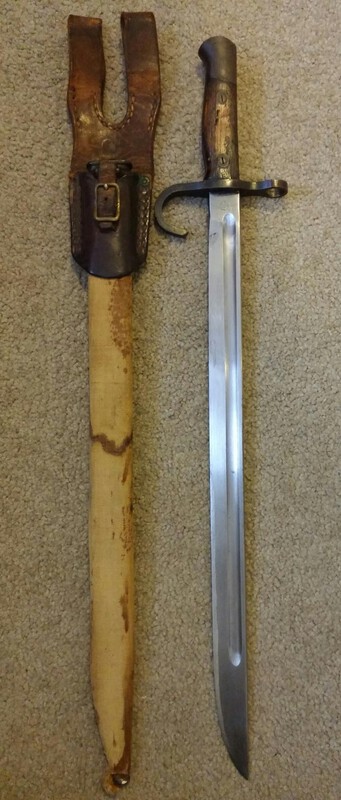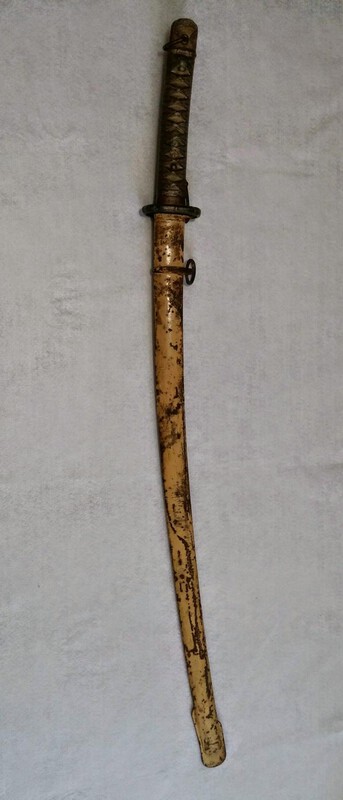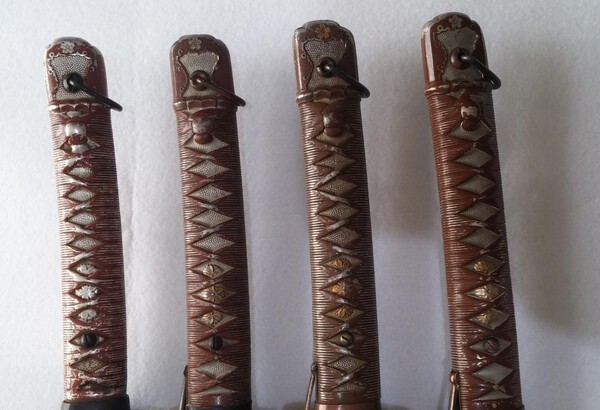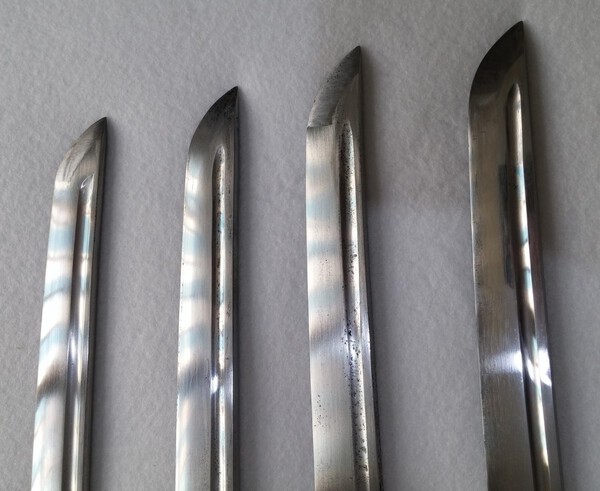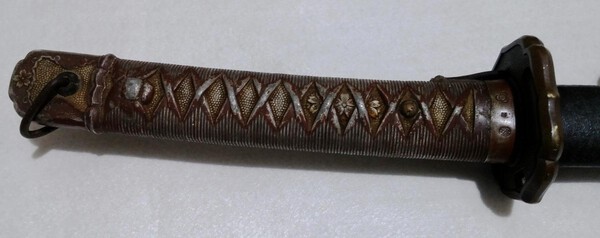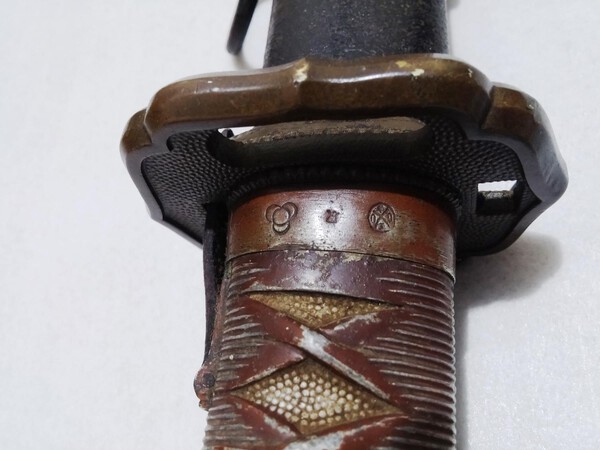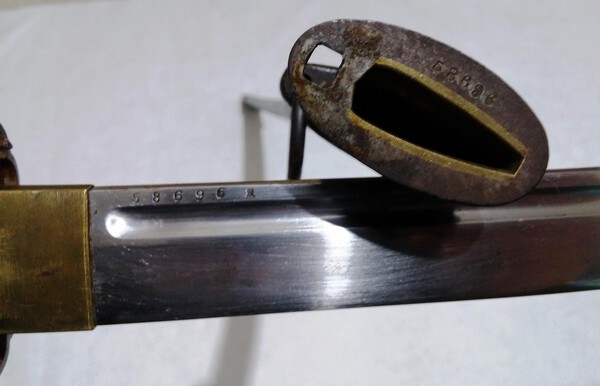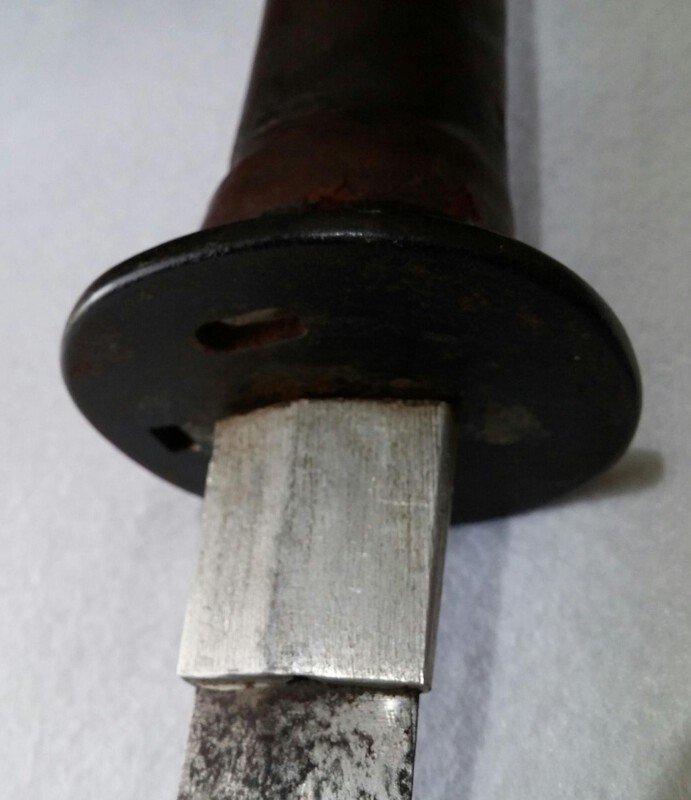-
Posts
1,402 -
Joined
-
Last visited
-
Days Won
11
Content Type
Profiles
Forums
Events
Store
Downloads
Gallery
Everything posted by Shamsy
-
Hi Allen, How refreshing and pleasant to have a post where you have actually conducted some research on your own before starting a thread! Far too many "I bought this what is it" where not even the slightest effort would have answered half the post and lead to opportunities for further research and learning. I'll take a look through references and see if I can pin the stamp. I look forward to hearing what you've managed to deduct about your sword Update: My best bet is poorly struck Sho or Seki stamp. On page 197 of Modern Japanese Swordsmiths you can see two such examples which seem close enough to be within reason.
-
While that is certainly true Bruce, the numbers of mismatched put-togethers is also increasing, so watch that these are not mistaken for something new.
-
Hi Julien, Thank you for the picture of the bayonet! That's a really special piece and great to see the paint has that same off cream colour! Keep a hold of that one. Here is my Muckden bayonet in the white canvas covered scabbard. These are winter covers that LaBar states would have been used in places like the Aleutian Islands. Since this example and another I have seen are both Muckden arsenal made, it's reasonable to assume they were issues to troops in China during the harsh winters.
-
I cannot smell or touch the leather seppa, so you're best to determine once you get the sword in hand. The brass seppa on 32 are thought to be from arsenal refurbished blades that usually were unissued before the war ended. Would be nice to have one as an example. 32s can be a collection in and of themselves. A good place to start when you're on a budget. Around 10 different ones I think, then add any oddities that come along.
-
I'll have my Yasumitsu polished. The cost of the sword in total will be about equivalent to the total value. But that's not really it. It's a great sword and worth restoring in its own right. Sometimes it's not about the money. Best to have cost as close to value as possible, but unless you're flipping swords off every couple of years the money you might lose is the price you pay for enjoying the sword.
-
Can be either. Leather seppa are used regularly by collector's to prevent the rattle that comes with drying wood of the tsuka shrinking. Some of these leather seppa are also period and perfectly legitimate. Some incorporate retention mechanisms such as buttons, though a lot of those are broken. Leather tends to shrink and harden to remember. Having said that I have a Type 32 Ko in the first 1500 produced with the leather washer intact, not to mention plenty of examples where leather has been well preserved. The best judge is feel and smell. Does it smell old and oily? Like it's had grime and use for a long time. Does it look like a 60 year old bit of leather? Is it smooth or kind of rough and weathered?
-
You should grab a few books Greg, so you can do some preliminary investigation into what you find. For military swords, the old classic is Swords of Imperial Japan by Jim Dawson. While it's a fairly limited work (but it'd take a library for a full catalog) it provides the basic patterns of most kinds of military sword. A quick look through showed me that while there were parts of this sword that matched with known patterns, there were none close enough. Primarily the serial numbers and Kokura stamp do not seem to appear on any pattern bar NCOs, nor do any but Manchurian swords have such a steep curve to the knuckle guard.
-
I likewise have an identical sword made by the Tokyo First Arsenal through the Suya subcontractor, showing considerable wear unfortunately.
-
Sorry, I was distracted and am replying a little late! I've had a good look at the habaki. From this I can draw the conclusion.... that I don't know. I think there is a tiny little mold line next to the ha, which could be either a weld or the result of casting. I cannot see any other signs of a weld. The picture I attached earlier shows what I wanted to confirm. Some of the silver metal actually runs onto the blade (you can see that on the left hand side). The little gap to the right is possibly where the metal was poured in? I'll leave that to people who have better experience in that field. Ultimately, I think you could be right Dave. The habaki may be cast to the blade.
-
Okay, I can see this thread is wind(y)ing down (I had to do it). I though I would share some of the variations rather than just stating that they exist in my previous posts. Knowing is all well and good, but better to have seen some pictures right? My only aim on the forum is to learn and educate, after all. I second what Stegel has stated about the two swords he found for your consideration. The first is more original, even if the paint is rough. That it includes a tassel is a bonus. It would be a good first piece and you will learn a lot form there. The auction sword will also go far higher than you'd expect; likely a lot more than those two. It's not a good version with the scabbard repaint and loose handle either, so you'd only want to move it on later, unless you are the sentimental sort. For the record this thread was never an argument for me. I find the topic exhilarating, exciting and educational. It is my main passion and hobby collecting and studying NCO's. I've very much enjoyed a rigorous debate which has really fired my interest (evident by the fact I took photos which I can rarely be bothered to do). Good luck all!
-
Before someone jumps on this, you can only compare tsuka from the same manufacturer and even within a similar serial range.
-
Oh! I'd forgotten about this one I used to own. Higher serial numbers but basically a match to the sword in question. It was a good example but unfortunately the scabbard was also a repaint. There was still a little of the original olive around the throat and when I took the throat out, the brass locking bar confirmed repaint (it was the original olive green to. PS that is the best way to tell if the paint is original since I don't think anyone every takes the throat out). I decided to upgrade so sold (and yes, I stated it was repainted). The sword has a rounded termination to the bohi. I can run these through a programme ( ) to lighten them up if you like. They're pretty dark I admit. EDIT: Fixed the pics as best I could
-
These were two points of contention but it sounds as though the answers fall squarely within the genuine camp? I admit I'm not exactly sure what you mean on the dots Windy, but the fact that you say they are raised in my mind refutes the main sticking point of the against argument. The saya throat with the brass ring is absolutely correct and visible in Wind's first post? Numbers are absolutely correct and match multiple examples on numerous other swords?? Even Dawson mentions that some are shallow, some deep. This was recently discussed in some detail in the thread Bruce raised for his pattern 4 (side lock aluminum ). Examples abound of shallow and slightly off struck fuchi stamps, not to mention variations. That's not a valid sign of a fake at all. The paint wont help. Typically fakes have the wrong symbol, order or fonts (though fonts legitimately vary and there is at least one example of a copper handle with the stamps in the wrong order! Addressing the fit, considering it has been disassembled, not surprising! It wasn't put together correctly. Rattle is not uncommon when the wooden tsuka lining shrinks. The quality of tsuka casting decreased over time. I was also dependant on the manufacturer. There are also several different wraps and hilt variations. This one looks spot on. But this has already been said before. With some pretty good evidence I thought. Time to make out own assessment.
-
I actually think that is an optical illusion. When I first looked I agree; it appeared to be indentations. Then after about ten seconds I saw them as raised. The black colour does not help. While no one doubts you have plenty of experience, do you think the people who disagree have only seen a couple of NCOs and been collecting one or two years? It's all well and good to say 'I've been collecting this long', but so have others (longer and more specifically NCOs in fact). I do genuinely mean this with respect, I just don't think you can dismiss other opinions on that basis. So far, IMHO, the only points that have not been credibly disproven are the possibility the same is indented (though I think that's a trick of the eyes). The serial number match the range for the style, fuchi stamps are fine, handle patina all good, signs of age, the loose lock is probably from disassembly (which is why the handle is loose), the termination of the bohi is not unusual shape merely one of a couple used, I think the serial number being clean really proves nothing (it also is probably just a result of the flash on steel), all the details of the sword (correct orientation, scabbard type etc) are good and finally yes, no one ever doubted the scabbard was a repaint! It's good to discuss and debate. Ultimately we are all unlikely to change our opinions as is so often the way of the Internet, but it's a good learning experience anyway. Perhaps when we hear if the casting is indented or raised we will be in a better position to reach a determination.
-
That's not an unreasonable sentiment John, not to mention Neil sums up the general concensus it's not the best example anyway.
-
That's a very odd but really interesting combo of fittings Neil. I have a bit of a thing for leather covered swords but this is something even more! As leather was used later in the war on more swords, I dare say it would be fair guess work that it could have been due to a shortage of available fittings?? I liked Daves assessment as a form of protection, but if there is nothing to protect... Perhaps it is just a preference, or maybe Bruce is right and it is an older sword with unusual fittings? Whatever the case it's very unique and I'm enjoying the speculation.
-
Stegel is spot on here. I have several swords with hand stamping of serial numbers. Provided these are the right font there is absolutely nothing wrong with them. They're regularly wonky, half struck, shallow... it's all been discussed in other threads. Seems that early on they rolled numbers and these were deep set and uniform. Later they get rough, though the Jinsen arsenal used proper stamping equipment again, as evidenced by the regular over struck 3. They also have a completely different font again. There is absolutely zero doubt about the numbers. Fuchi stamps are fine. I've got examples of great stamps and average one's. Also, things like the Kokura cannon ball stamp is found in a variety of styles, which is easy to see in Dawson. As fate would have it, that sword arrived yesterday Stegel. Thought it was a gonna. You really can't judge NCOs based off such limited reference material as Dawson and F&G. They did a fantastic job of providing us SOME material from nearly none, but they have such a tiny section and sample on the NCOs. There are SO MANY valid variants. I am of the opinion the sword is original, if not the paint on parts. Having said that, I agree with Hamish on one points. The scabbard retention is not well fitted which is unusual. They're usually pretty well flush and precise, as is typical of Japanese engineering. The end of the bohi where it meets the kissaki is round. My sword does have that kissaki shaped termination. Having said that a quick check shows me that I have a Seki, Gifu and Seki side latch with rounded ends to the bohi. Not that unusual. If this is a fake causing this much debate we are all in serious trouble.
-
It certainly looks like it. I can't get the tsuka off either to confirm, but I'd say it'll be a late was mumei with painted kanji. I think Dave could be right about the habaki being cast onto the blade. In the photo you can sort of make out where it looks as though the metal has run slightly. I'll take a better look tonight.
-
I do sympathise, though I find that we have such a mix of pronunciation and spelling between British and American it's difficult to tell the difference. The fact most of these gadgets use English (US) doesn't help. I insist on s instead of z, but otherwise don't worry. Tell you what, when I've put programme instead of program people look at you like an alien... Back in topic, I'd totally forgotten that you were a metallurgist Neil! You would be well placed to make a determination. Unfortunately, as I mentioned the sword is rough from years in a shed or similar, so I have no hope of removing the habaki to check the weight.
-
Please forgive me for my terrible transgression of a typo Mr Flynn. To be honest Dave I cannot say that it is aluminium with any real certainly. It's welded to the blade with rust so I'm not able to take or off. It certainly look like aluminium though. Has anyone got any other examples of aluminium habaki? Or even confirmed that they are aluminium, since Dave could very well be correct that these are a form of alloy instead...
-
I thought I'd mention I have a habaki that's made of aluminum. It's on a late war leather covered sword. Quite unusual.
-
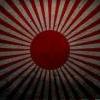
Quick Opinion On This Auction Sword?
Shamsy replied to Daddy Cool's topic in Military Swords of Japan
100% genuine type 98 in rough condition -
I'll parrot what has been said. Genuine but certain that the scabbard was repainted. The fuchi is interesting because you can clearly see a pattern of dust behind the retaining spring. The same is true around the seppa, suggesting its not been dissembled for a while, if at all. I'm not certain the fuchi was repainted (at least recently). As Bruce said, the black same is not something I've seen, but general patina suggests to me the handle was not repainted.
-
I'm pulling the sword from sale. Thank you for the complements and correcting my blunders.
-
I absolutely refuse to use FedEx. They are an awful company. The only time I've ever had a sword opened was via FedEx, not even by customs! They damaged the kissaki, couldn't care less and made me feel the whole time like it was some kind of witch hunt, despite my knowing full well that sword importation into Australia is unrestricted.



